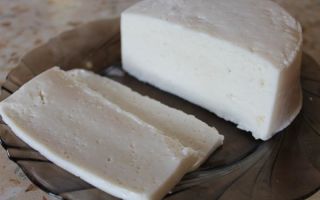Content
- 1 Features of goat cheese
- 2 The composition and calorie content of goat cheese
- 3 The benefits of goat cheese
- 4 Is goat cheese good for weight loss?
- 5 Homemade Goat Cheese Recipe
- 6 The use of goat cheese in cooking and cosmetology
- 7 The harm of goat cheese and contraindications
- 8 How to choose and store goat cheese
- 9 Conclusion
The goat was domesticated more than 5 thousand years ago, and it is the goat cheese was the first human-tasted product of this type. The benefits and harms of goat cheese have stood the test of time and are well known. Today this product is quite rare due to the dominance of cow's milk products. And this situation must be urgently corrected, since its useful properties are diverse and in some way irreplaceable.
Features of goat cheese
As the name suggests, this cheese is made from goat's milk. Unlike the traditional cow, it has a number of features:
- It has a lower calorie content.
- It has a high concentration of lactic acid bacteria, being essentially "hard yogurt". Most of these bacteria are predators, which makes the product a natural antibiotic.
- During the production process, virtually all of the lactose and other irritating substances in milk are fermented. This makes cheese not only a hypoallergenic product, but also makes it possible for people with lactose intolerance to use it.
- The digestibility of this product is better than that of bovine, since its lipids are better processed by humans.
- The content of trace elements (in particular, calcium) in this type of cheese is higher than in cow.
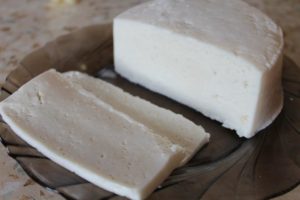
The listed beneficial properties make goat cheese more attractive than cow's milk cheese. However, there are objective reasons why it is currently not very common.
The first is the high price of the product, since a lot of milk is required to produce it, and a goat, unlike a cow, is a small animal. The second is a specific smell that many people don't like.
The composition and calorie content of goat cheese
It is rather difficult to estimate the quantitative composition of the product; moreover, it changes significantly depending on the manufacturing technology. Therefore, we can only talk about what substances are included in its composition, without indicating their concentration.
The vitamin composition of the product is as follows:
- vitamins A and PP;
- B vitamins;
- vitamin C;
- vitamins E and D.
It includes the following trace elements:
- calcium (one of the highest concentrations in animal products);
- potassium;
- magnesium;
- phosphorus;
- iron;
- zinc.
The nutritional value of the product also significantly depends on the variety. Average indicators are approximately as follows:
- proteins - 29%
- fat - 67%
- carbohydrates - 1%.
The average calorie value of goat cheese per 100 grams is 290 kcal.
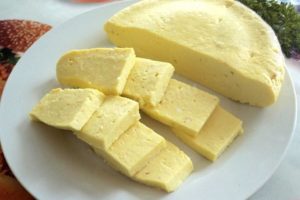
In practice, the calorie content of homemade goat cheese may differ from this value. It depends on the fat content of the milk used. In the literature, figures are given from 250 kcal to 320 kcal per 100 g of the product.
The benefits of goat cheese
The benefits of goat cheese for the human body are enormous. Thanks to the unique combination of substances included in it, goat's milk cheese has a lot of useful properties and has a beneficial effect on almost all body systems.
It normalizes the functioning of the skeletal system and strengthens it. This is possible due to the high content of calcium in the product.
The product improves digestion. The beneficial bacteria contained in it contribute to faster digestion of food.
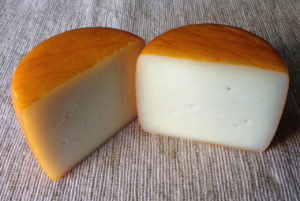
The beneficial properties of the product are also manifested in the prevention of atherosclerosis. The substances contained in it contribute to the dissolution of cholesterol plaques. This is especially evident in the vessels of the brain.
The product has a positive effect on the circulatory system in general. It is recommended for people suffering from hypertension, ischemic heart disease and tachycardia. The beneficial properties of cheese make it indispensable for arrhythmias.
The beneficial properties of cheese can eliminate many problems of the genitourinary system.
The active substances contained in the product accelerate the metabolism and promote the burning of fats in the body. The fats that make up the product, due to their structure, are very quickly broken down and do not lead to excess weight gain. The combination of these beneficial properties makes goat milk cheese one of the recommended foods for weight loss.
The product will also be useful for skin, hair and nails. Due to its high vitamin D content, the product is used in a large number of nourishing masks for the body and hair.
For women and men
In the female body, the beneficial properties of cheese are manifested in the reduction of menstrual pain. He is able to eliminate inflammatory processes in the genitourinary system. The beneficial bacteria contained in it help to suppress the development of candidiasis and other infectious diseases.
The use of cheese is shown for pregnant and lactating women, since it not only replenishes the amount of calcium in the body, but also contributes to the proper development of the fetus in the womb.
For men, cheese will be useful primarily due to the high concentration of phosphorus and proteins, which provides nutrition to the muscular system. The beneficial properties of the product are equally important in strengthening the functions of the male reproductive system.
For the elderly
Goat cheese is good for the elderly as it prevents bone breakdown.

For children
The main use of this product in baby food is to provide the growing body with sufficient calcium and phosphorus. These beneficial substances will allow the bone and muscle systems of a growing body to form correctly.
The product has no contraindications, since it is hypoallergenic and can be eaten by children from 18 months.
Is goat cheese good for weight loss?
Since the product contains easily digestible fats and helps to accelerate metabolic processes in the body, it can be used for losing weight. At the same time, thanks to the proteins contained in the cheese, it will be able to replace many products containing them. Diets based on it are based on just such a substitution.

Homemade Goat Cheese Recipe
Making such a cheese at home is very simple. This, one might say, is one of the oldest recipes for dairy products of our civilization. This will require: 2 liters of goat milk, 1 lemon, a pinch of salt.
Sequencing:
- Salt is added to the milk and heated to a temperature of + 90 ° (until bubbles appear), however, it is not brought to a boil.
- Lemon juice is added to the heated milk by squeezing it drop by drop from the cut lemon. The drop rate is once every 5 seconds. After about 1.5-2 minutes. serum will begin to be released.
- Gauze or a wide bandage is placed in a sieve or colander. The resulting dishes are placed over a clean pan or any container. The whey is poured into a sieve.
- After half an hour, a workpiece of the correct shape is formed from the curd mass, compacted and placed in the refrigerator.
You can try it in a couple of hours, but it's better to wait about a day. The yield of the final product from 2 liters of milk is about 270-300 g. If there is a desire to obtain a porous product, 2-3 g of soda is added to the whey before it is poured onto a sieve.
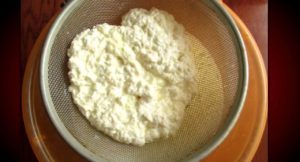
The use of goat cheese in cooking and cosmetology
The product is widely used in cooking. It is used as an independent dish - as an appetizer for wine or dessert, or as a component of more complex dishes. It is most commonly used in salads or casseroles.

In cosmetology, liquid products are more often used (goat's milk and cream and sour cream obtained from it), however, cheese is also used. Cheese masks have a tonic effect on the skin. They are applicable to all skin types. The nutritional effect of these masks is superior to those made from cow cheese.
The harm of goat cheese and contraindications
Due to the nature of production and marketing, it is currently difficult to find commercially made goat cheese. Therefore, most of the cheeses that consumers encounter today are not pasteurized but raw products. This is the main danger of goat's milk cheese and its harm to humans - the presence of pathogenic bacteria. For example, salmonella or Koch's sticks.
It is desirable, of course, to purchase a product made not only "according to the recipes of ancient masters", but also according to modern safety standards. This can only be guaranteed by a responsible manufacturer. Unfortunately, currently there are very few of them.
From a chemical point of view, the product poses a hazard to three categories of patients:
- patients with diseases of the stomach (ulcer, gastritis and others); this type of cheese has a high acidity, so this group should not abuse it;
- suffering from gout;
- having allergies or individual intolerance.
Cases of allergies or individual intolerance to the product are actually extremely rare (less than 1 case per million).
Sometimes, especially when the product is eaten for the first time, there is discomfort in the abdomen, but as a rule, it does not go further than unpleasant sensations.
How to choose and store goat cheese
It is believed that the best cheese is produced between the beginning of May and the end of September. It is at this time that the diet of goats is the most varied and healthy. Therefore, the first selection criterion is the production date.
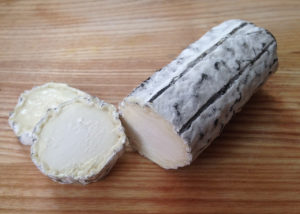
Equally important is the presence of impurities, in particular, other types of milk. Real goat cheese is made exclusively from goat's milk; it should not contain cow's milk.
The appearance of the product depends on the cooking technology and can be very diverse. The main requirement is uniformity of color and the same consistency.
It is difficult to say something by smell, since the smell of the product, firstly, is specific, and secondly, the presence of fungi or mold is often a production technology, and not at all a violation of storage conditions.
Storage times depend on the hardness of the product. Soft cheese lasts about 15 days, hard cheese - about three months. Store the product in the refrigerator.
Conclusion
The benefits and harms of goat cheese have long been known. It is widely used in cooking and can serve as a snack or a delicacy. In fact, this product has no contraindications and can be used by all without exception. Restrictions can be imposed only on the volume of its use. Its beneficial properties help the body cope with many problems, both internal and external. Everyone is encouraged to introduce this product into their diet.

